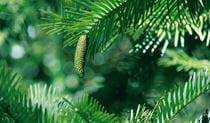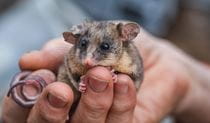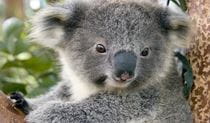Rufous scrub-bird
The vulnerable rufous scrub-bird is a small, ground-foraging bird that lives only in isolated rainforest areas of south-eastern Australia.
The rufous scrub-bird is a stocky bird that grows to around 17cm long. Adults are a scaly-patterned dark rufous-brown, with a light throat, long rounded tail, and dark brown eyes.
What's in a name? The word “rufous” comes from the latin word for red: rufus. You’ll see it used to describe animals that have reddish-brown feathers, fur or skin, like the rufous bettong, rufous net casting spider, and rufous scrub-bird.
Scrub-birds spend most of their time on the ground, foraging in deep, moist litter beneath a dense layer of vegetation. They scuttle through litter using their head and beak to toss leaves aside to search for small invertebrates, including snails and insects.
They breed from early spring to summer, building a dome-shaped nest on or close to the ground. However, very little is known about their breeding behaviour because they’re so shy and hard to see, and their habitat is so dense.
Heard but not seen
These birds might be hard to see, but the loud, regular calls of the males are often heard if they’re nearby. These include territorial calls (repeated sharp high-pitched chip, chip) as well as mimicry. Male calling peaks in the breeding season but continues throughout the year.

Listen to one of the rufous scrub-bird's common calls
Audio © David Stewart Naturesound
Distribution and threats
Rufous scrub-birds are only found in the Gondwana Rainforests of eastern Australia. The northern subspecies (Atrichornis rufescens rufescens) exists between the Gibraltar Range in northern NSW and the Mistake Range in Queensland. The southern subspecies (Atrichornis rufescens ferrieri) is restricted to NSW, with patchy distribution from the Dorrigo Plateau to Barrington Tops.
They once foraged lower altitude forests in far north-eastern NSW. Today, the shy scrub-birds are restricted to high-rainfall forests above 600m elevation. These small, isolated populations are at risk of local extinction from the effects of climate change and habitat disturbance.
NSW National Parks and Wildlife Service (NPWS) has a targeted strategy for minimising threats and managing this species under the Saving our Species program.
Animal facts
- Common name
- Rufous scrub-bird
- Scientific name
- Atrichornis rufescens
- Conservation status in NSW
- Vulnerable
Extra special protections
Several areas within NSW national parks have been declared Assets of Intergenerational Significance (AIS) to provide the strongest protections for rufous scrub-birds and their habitat. These include:
You might also like
-

Assets of Intergenerational Significance (AIS)
Assets of Intergenerational Significance (AIS) are declared to bolster protections for an area with exceptional environmental or cultural values, like...
-

Protecting threatened species in parks
Around 84% of the approximately 900 threatened species in NSW are found in our national parks and reserves. Find out what we're doing to protect threa...
-

Saving our Species conservation program
Today, we're at risk of losing nearly 1000 of our state's native animals and plants. That's why the NSW Government established Saving our Species. It'...

